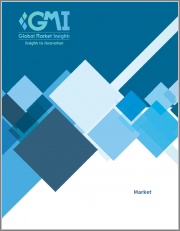
|
시장보고서
상품코드
1359588
세계의 암 지지요법 약제 시장 규모 - 약물 유형별, 암 유형별, 유통 채널별, 세계 예측(2023-2032년)Cancer Supportive Care Drugs Market Size - By Drug Class, Cancer type, Distribution Channel, Global Forecast (2023 - 2032) |
||||||
암 지지요법 약제 시장 규모는 세계 암 발병률 증가로 인해 2023년부터 2032년까지 1.9%의 연평균 복합 성장률(CAGR)을 나타낼 것으로 예상됩니다.
미국 암 통계청 자료에 따르면, 2020년 한 해 동안 150만 명 이상의 암 환자가 새로 발생했으며, 그 중 60만 2,347명이 사망한 것으로 보고됐습니다. 암 환자 수가 지속적으로 증가함에 따라 화학요법, 방사선 요법 등 암 치료의 부작용을 완화하는 치료법에 대한 수요가 급증하고 있습니다.
또한, 암 치료 중 삶의 질(QOL)의 중요성에 대한 인식이 높아짐에 따라 이러한 약물의 사용은 더욱 가속화되고 있습니다. 환자들이 증상을 관리하고 더 높은 수준의 편안함과 행복감을 유지할 수 있는 방법을 모색함에 따라, 암 지원 치료 솔루션이 인기를 끌 것으로 보입니다.
암 지지요법제 시장은 약제군별, 암종별, 유통채널별, 지역별로 분류됩니다.
오피오이드 분야는 2023년부터 2032년까지 약 2.4%의 연평균 복합 성장률(CAGR)을 나타낼 것으로 예상됩니다. 오피오이드는 암 관련 통증 관리에 효과적인 것으로 알려져 있어 암 치료 중인 환자들에게 점점 더 많이 처방되고 있습니다. 오피오이드 제제가 발전함에 따라 부작용을 최소화하면서 최적의 진통 효과를 얻는 데 초점을 맞추고 있습니다. 이는 환자의 편안함을 향상시킬 뿐만 아니라 암 증상 관리에 대한 보다 종합적인 접근법을 제공할 수 있습니다.
폐암은 가장 발병률이 높고 공격적인 암 중 하나로, 2023년부터 2032년까지 연평균 2.5%의 성장률을 나타낼 것으로 예상됩니다. 폐암 환자들은 통증, 호흡곤란, 피로감 등 다양한 고통스러운 증상을 호소하는 경우가 많습니다. 따라서 폐암 환자만의 특성에 맞는 지지요법 약제에 대한 수요가 높습니다. 환자의 삶의 질을 개선하기 위한 폐암에 대한 혁신적인 약물 및 치료법 개발이 업계 성장을 견인하고 있습니다.
북미 암 지원 의약품 산업은 탄탄한 의료 인프라, 광범위한 R&D 활동, 높은 암 발병률에 힘입어 2023년부터 2032년까지 연평균 1.7%의 성장률을 보일 것으로 예상됩니다. 미국과 캐나다는 암 지지요법 추진의 최전선에 서서 연구개발에 많은 투자를 하고 있으며, 환자들이 가장 효과적인 최신 지지요법 약제을 이용할 수 있도록 지원하고 있습니다. 북미에서는 암 치료 중 환자의 편안함과 행복에 대한 중요성이 강조되고 있으며, 이는 향후 시장 확대의 원동력이 될 것으로 보입니다.
목차
제1장 조사 방법과 조사 범위
제2장 주요 요약
제3장 암 지지요법 약제시장, 업계 인사이트
- 생태계 분석
- 업계에 대한 영향요인
- 성장 촉진요인
- 업계의 잠재적 리스크&과제
- 성장 가능성 분석
- COVID-19의 영향 분석
- 규제 상황
- Porter의 Five Forces 분석
- PESTEL 분석
제4장 경쟁 구도
- 서론
- 기업 매트릭스 분석
- 기업 포지셔닝 매트릭스
- 주요 시장 기업의 경쟁 분석
- 전략 대시보드
제5장 암 지지요법 약제 시장 규모와 예측 : 약제 클래스별
- 주요 동향 : 약제 클래스별
- G-CSFs(과립구 증식 촉진 당단백질)
- ESAs(적혈구 조혈 자극인자)
- 제토제
- 비스포스포네이트
- 오피오이드
- 비스테로이드성 항염증제
- 기타 약제
제6장 암 지지요법 약제 시장 규모와 예측 : 암 유형별
- 주요 동향 : 암 유형별
- 유방암
- 폐암
- 흑색종
- 전립선암
- 대장암
- 간암
- 위암
- 기타 암
제7장 암 지지요법 약제 시장 규모와 예측 : 유통 채널별
- 주요 동향 : 유통 채널별
- 병원 약국
- 드럭스토어 및 소매 약국
- 온라인 약국
제8장 암 지지요법 약제 시장 규모와 예측 : 지역별
- 주요 동향 : 지역별
- 북미
- 미국
- 캐나다
- 유럽
- 독일
- 영국
- 프랑스
- 스페인
- 이탈리아
- 기타 유럽
- 아시아태평양
- 일본
- 중국
- 인도
- 호주
- 기타 아시아태평양
- 라틴아메리카
- 브라질
- 멕시코
- 기타 라틴아메리카
- 중동 및 아프리카
- 남아프리카공화국
- 사우디아라비아
- 기타 중동 및 아프리카
제9장 기업 개요
- Amgen, Inc.
- Merck & Co., Inc.
- Johnson & Johnson Services, Inc.
- Heron Therapeutics, Inc.
- Novartis AG
- GSK plc
- F. Hoffmann-La Roche Ltd.
- Helsinn Healthcare SA
- Teva Pharmaceuticals Industries Ltd.
- Fagron Group
Cancer supportive care drugs market size is predicted to witness 1.9% CAGR from 2023 to 2032 due to the escalating incidence of cancer worldwide. According to the data from the United States Cancer Statistics, more than 1.5 million new cancer cases were reported in 2020, out of which nearly 602,347 deaths were reported. As the number of cancer cases continues to rise, the demand for therapies that alleviate the side effects of cancer treatment, such as chemotherapy and radiation therapy, is surging.
Additionally, the growing awareness about the importance of quality of life during cancer treatment has fueled the usage of these drugs. As patients seek ways to manage their symptoms and maintain a higher level of comfort and well-being, the cancer support care solutions will gain traction.
Cancer supportive care drugs market is divided based on drug class, cancer type, distribution channel, and region.
The opioids segment is expected to record around 2.4% CAGR from 2023 to 2032. As opioids are known for their effectiveness in managing cancer-related pain, they are increasingly prescribed to patients undergoing cancer treatment. With advancements in opioid formulations, the focus has shifted toward achieving optimal pain relief while minimizing side effects. This is not only enhancing patient comfort but also providing a more comprehensive approach to managing cancer symptoms.
The lung cancer segment is anticipated to observe 2.5% CAGR during 2023 and 2032 as it is one of the most prevalent and aggressive types of cancer. Patients with lung cancer often suffer from a range of distressing symptoms, including pain, breathlessness, and fatigue. As a result, there is a high demand for supportive care drugs tailored to the specific needs of lung cancer patients. The development of innovative drugs and therapies for lung cancer for improving the quality of life for patients is driving the industry growth.
North America cancer supportive care drugs industry is expected to witness 1.7% CAGR from 2023 to 2032, favored by a robust healthcare infrastructure, extensive R&D activities, and high cancer prevalence. The United States and Canada are at the forefront of advancing cancer supportive care, investing heavily in R&D, and ensuring that patients have access to the latest and most effective supportive care drugs. The emphasis on patient comfort and well-being during cancer treatment in North America will continue to drive the market expansion.
Table of Contents
Chapter 1 Methodology & Scope
- 1.1 Market scope & definition
- 1.2 Base estimates & calculations
- 1.3 Forecast parameters
- 1.4 COVID-19 impact analysis at global level
- 1.5 Data validation
- 1.6 Data Sources
- 1.6.1 Primary
- 1.6.2 Secondary
- 1.6.2.1 Paid sources
- 1.6.2.2 Unpaid sources
Chapter 2 Executive Summary
- 2.1 Global cancer supportive care drugs market 360 degree synopsis, 2018 - 2032
- 2.1.1 Business trends
- 2.1.2 Regional trends
- 2.1.3 Drug class trends
- 2.1.4 Cancer type trends
- 2.1.5 Distribution channel trends
Chapter 3 Cancer Supportive Care Drugs Market Industry Insights
- 3.1 Industry ecosystem analysis
- 3.2 Industry impact forces
- 3.2.1 Growth drivers
- 3.2.1.1 Rising incidence and prevalence of cancer
- 3.2.1.2 Increasing technological advancements in cancer therapies
- 3.2.1.3 Rising geriatric population
- 3.2.1.4 Growing integration of digital health
- 3.2.1.5 Increasing awareness among patients and healthcare professionals about the availability and benefits of supportive care drugs
- 3.2.2 Industry pitfalls & challenges
- 3.2.2.1 Availability of alternative therapies or complementary treatments
- 3.2.2.2 Limited healthcare resources
- 3.2.2.3 Adverse effect drugs
- 3.2.1 Growth drivers
- 3.3 Growth potential analysis
- 3.3.1 By drug class
- 3.3.2 By cancer type
- 3.3.3 By distribution channel
- 3.4 COVID- 19 impact analysis
- 3.5 Regulatory landscape
- 3.6 Porter's analysis
- 3.7 PESTEL analysis
Chapter 4 Competitive Landscape, 2022
- 4.1 Introduction
- 4.2 Company matrix analysis, 2022
- 4.3 Company positioning matrix, 2022
- 4.4 Competitive analysis of major market players, 2022
- 4.5 Strategy dashboard, 2022
Chapter 5 Cancer Supportive Care Drugs Market Size and Forecast, By Drug class (USD Million)
- 5.1 Key trends, by drug class
- 5.2 G-CSFs (Granulocyte-colony Stimulating Factors)
- 5.3 ESAs (Erythropoiesis Stimulating Agents)
- 5.4 Anti-emetics
- 5.5 Bisphosphonates
- 5.6 Opioids
- 5.7 NSAIDs
- 5.8 Other drugs
Chapter 6 Cancer Supportive Care Drugs Market Size and Forecast, By Cancer type (USD Million)
- 6.1 Key trends, by cancer type
- 6.2 Breast cancer
- 6.3 Lung cancer
- 6.4 Melanoma
- 6.5 Prostate cancer
- 6.6 Colorectal cancer
- 6.7 Liver cancer
- 6.8 Stomach cancer
- 6.9 Other cancer types
Chapter 7 Cancer Supportive Care Drugs Market Size and Forecast, By Distribution channel (USD Million)
- 7.1 Key trends, by distribution channel
- 7.2 Hospital pharmacies
- 7.3 Drug stores and retail pharmacies
- 7.4 Online pharmacies
Chapter 8 Cancer Supportive Care Drugs Market Size and Forecast, By Region (USD Million)
- 8.1 Key trends, by region
- 8.2 North America
- 8.2.1 U.S.
- 8.2.2 Canada
- 8.3 Europe
- 8.3.1 Germany
- 8.3.2 UK
- 8.3.3 France
- 8.3.4 Spain
- 8.3.5 Italy
- 8.3.6 Rest of Europe
- 8.4 Asia Pacific
- 8.4.1 Japan
- 8.4.2 China
- 8.4.3 India
- 8.4.4 Australia
- 8.4.5 Rest of Asia Pacific
- 8.5 Latin America
- 8.5.1 Brazil
- 8.5.2 Mexico
- 8.5.3 Rest of Latin America
- 8.6 Middle East & Africa
- 8.6.1 South Africa
- 8.6.2 Saudi Arabia
- 8.6.3 Rest of Middle East & Africa
Chapter 9 Company Profiles
- 9.1 Amgen, Inc.
- 9.2 Merck & Co., Inc.
- 9.3 Johnson & Johnson Services, Inc.
- 9.4 Heron Therapeutics, Inc.
- 9.5 Novartis AG
- 9.6 GSK plc
- 9.7 F. Hoffmann-La Roche Ltd.
- 9.8 Helsinn Healthcare SA
- 9.9 Teva Pharmaceuticals Industries Ltd.
- 9.10 Fagron Group



















